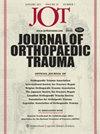Effects of Obesity on Systemic Complications after Operative Pelvic Ring Fractures
IF 1.6
3区 医学
Q3 ORTHOPEDICS
引用次数: 0
Abstract
To determine the effect of obesity on systemic complications after operative pelvic ring injuries. Design: Retrospective cohort study Single level 1 trauma center All patients at a level 1 trauma center who underwent operative fixation of a pelvic ring injury from 2015-2022 were included. Patients were grouped based on body mass index (BMI) into four categories (normal = BMI <25, overweight = BMI 25-30, obese = BMI 30-40, and morbidly obese BMI >40). Systemic complications including acute respiratory distress syndrome, pneumonia, sepsis, deep venous thrombosis (DVT), pulmonary embolism, ileus, acute kidney injury (AKI), myocardial infarction, and mortality were recorded. Patients who developed a complication were compared to those who did not in regard to demographic and clinical parameters to determine risk factors for each complication. A total of 1056 patients underwent pelvic ring fixation including 388 normal BMI, 267 overweight, 289 obese, and 112 morbidly obese patients. The average age of all patients was 36.9 years, with a range from 16 to 85 years. Overall, 631 patients (59.8%) were male. The overall complication and mortality rates were 23.2% and 1.4%, respectively. BMI was a significant independent risk factor for all-cause complication with an odds ratio (OR) of 1.67 for overweight, 2.30 for obese, and 2.45 for morbidly obese patients. The risk of DVT and AKI were also significantly increased with every weight class above normal with ORs of 5.06 and 3.02, respectively, for morbidly obese patients (BMI >40). This study demonstrated that among patients undergoing pelvic ring fixation, higher BMI was associated with increased risks of overall complication and specifically DVT and AKI. As the prevalence of obesity continues to increase in the population, surgeons should be cognizant that these patients may be at higher risk of certain post-operative complications during the initial trauma admission. Prognostic Level III. See Instructions for Authors for a complete description of levels of evidence.肥胖对骨盆环骨折术后全身并发症的影响
目的:确定肥胖对骨盆环损伤手术后全身并发症的影响。 设计:回顾性队列研究 单1级创伤中心 纳入2015-2022年期间在1级创伤中心接受骨盆环损伤手术固定的所有患者。根据体重指数(BMI)将患者分为四类(正常 = BMI 40)。 记录了全身并发症,包括急性呼吸窘迫综合征、肺炎、败血症、深静脉血栓形成(DVT)、肺栓塞、回肠梗阻、急性肾损伤(AKI)、心肌梗死和死亡率。将出现并发症的患者与未出现并发症的患者在人口统计学和临床参数方面进行比较,以确定每种并发症的风险因素。 共有 1056 名患者接受了骨盆环固定术,其中包括 388 名体重指数正常、267 名超重、289 名肥胖和 112 名病态肥胖患者。所有患者的平均年龄为 36.9 岁,从 16 岁到 85 岁不等。总体而言,631 名患者(59.8%)为男性。总体并发症发生率和死亡率分别为 23.2% 和 1.4%。体重指数是全因并发症的重要独立风险因素,超重患者的几率比(OR)为 1.67,肥胖患者为 2.30,病态肥胖患者为 2.45。体重每超过正常值一个等级,发生深静脉血栓和急性肾损伤的风险也会显著增加,病态肥胖患者(体重指数大于 40)的比值比分别为 5.06 和 3.02。 这项研究表明,在接受骨盆环固定术的患者中,体重指数越高,总体并发症风险越高,尤其是深静脉血栓和 AKI。由于肥胖症在人群中的发病率持续上升,外科医生应该认识到,这些患者在最初的创伤入院过程中可能会面临更高的术后并发症风险。 预后 III 级。有关证据等级的完整描述,请参阅 "作者须知"。
本文章由计算机程序翻译,如有差异,请以英文原文为准。
求助全文
约1分钟内获得全文
求助全文
来源期刊

Journal of Orthopaedic Trauma
医学-运动科学
CiteScore
3.90
自引率
8.70%
发文量
396
审稿时长
3-8 weeks
期刊介绍:
Journal of Orthopaedic Trauma is devoted exclusively to the diagnosis and management of hard and soft tissue trauma, including injuries to bone, muscle, ligament, and tendons, as well as spinal cord injuries. Under the guidance of a distinguished international board of editors, the journal provides the most current information on diagnostic techniques, new and improved surgical instruments and procedures, surgical implants and prosthetic devices, bioplastics and biometals; and physical therapy and rehabilitation.
 求助内容:
求助内容: 应助结果提醒方式:
应助结果提醒方式:


